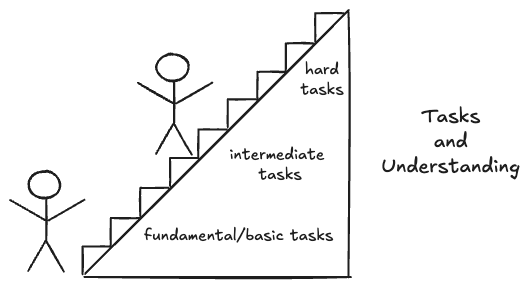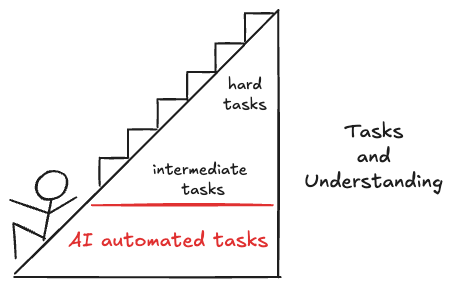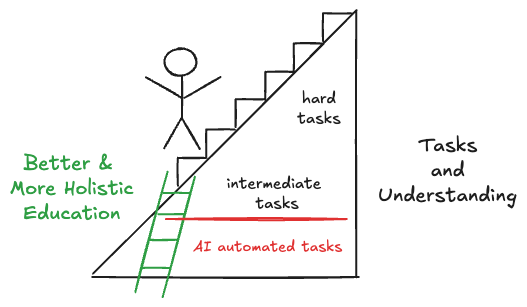[

](https://substackcdn.com/image/fetch/$s_!K-pt!,f_auto,q_auto:good,fl_progressive:steep/https%3A%2F%2Fsubstack-post-media.s3.amazonaws.com%2Fpublic%2Fimages%2Fed842e6d-4b65-439e-8415-9089d2bd9174_530x288.png)
The traditional path to professional competence.
For generations, the path to professional competence resembled climbing a staircase. Novices entered a field, were assigned work appropriate to their current level and gradually ascended. Early tasks, while sometimes rudimentary, served a crucial purpose: they provided repeated exposure, deliberate practice, and the opportunity to build foundational understanding and skills iteratively. Guided by mentors and structured feedback, trainees mirrored competencies, tackled progressively harder challenges, and solidified their learning. This step-by-step climb, supported by the scaffolding of supervised practice, allowed them to internalise the core logic and mechanics of their profession. Even if supplementary learning tools were weak, the sheer volume of hands-on practice eventually led most dedicated trainees up the stairs, albeit sometimes inefficiently.
The AI Slide: Automation Removes the Foundational Steps
[

](https://substackcdn.com/image/fetch/$s_!cvtF!,f_auto,q_auto:good,fl_progressive:steep/https%3A%2F%2Fsubstack-post-media.s3.amazonaws.com%2Fpublic%2Fimages%2Fa1a841aa-828f-4408-a209-7bd79de3ebd8_453x287.png)
The path to professional competence in the age of AI. It's so difficult for early education trainees to reach the higher levels as a result of automation at the fundamental levels.
This traditional model is being fundamentally disrupted. Generative AI (GenAI) and other automation tools are increasingly capable of executing many of the entry-level tasks that once occupied the crucial early stages of a professional's journey: drafting initial memos, summarising research, performing basic data analysis, writing simple code snippets – tasks that required grappling with fundamentals – can now be largely automated.
For organisations, the allure is obvious: efficiency gains, cost savings, and the ability for existing staff to focus on higher-value activities. However, this automation creates a perilous "AI Slide" in the staircase of competence. By removing the need for novices to perform these foundational tasks, we inadvertently remove the natural environment for essential, hands-on practice.
The core problem isn't just about losing practice time. It's about losing the cognitive processes that practice enables:
- Weakened Fundamentals: Without wrestling with the basics, the underlying principles, rules, and nuances of a field aren't deeply encoded. The "why" behind the "what" remains elusive. Automaticity (the ability to do things without occupying the mind with the low-level details required, allowing it to become an automatic response pattern or habit) in basic skills frees up working memory for higher-level thinking; AI risks preventing this automaticity from ever developing.
- Inability to "Latch On": Learning is hierarchical. Advanced concepts build upon simpler ones. If the foundational steps are missing or merely observed (by reviewing AI output), learners struggle to connect new, complex information to a solid base. They can't "latch on" to higher-level content because the necessary mental schemas haven't been constructed through active engagement.
- The Illusion of Competence: Reviewing or lightly editing an AI-generated output feels productive, but it's fundamentally different from creating it from scratch. It bypasses the "desirable difficulty"that solidifies learning. Verification requires a different cognitive skillset than generation. This can lead to novices (and their managers) overestimating their true understanding and capability.
- Impaired Critical Evaluation: How can someone critically evaluate the output of an AI performing a complex task if they've never performed the underlying steps themselves? True critical evaluation requires not just knowing what the right answer looks like, but understanding how it's derived and why alternative approaches might be flawed. Without the ingrained experience of the fundamentals, evaluating sophisticated AI output becomes superficial guesswork.
The Need for the Educational Ladder

Only better, more holistic education can substitute the real-world practice and skills that are required to practice and master the fundamentals in order to move to intermediate and harder tasks and allow the professional to move up the competence stairs again.
If AI automates the lower steps of the staircase, how do novices reach the top? Simply throwing them onto higher-level tasks won't work—they lack the foundation. Relying solely on AI verification tasks won't build deep competence.
This is where structured, deliberate education and training become more critical than ever before. We can no longer rely solely on on-the-job osmosis for foundational skill development. We need to build "Educational Ladders": intentional learning pathways designed to compensate for the practice opportunities lost to automation.
These ladders must:
- Focus on Fundamentals: Explicitly teach and provide deliberate practice on the core principles and skills that AI now obscures in entry-level work. This requires breaking down concepts into granular steps (micro-scaffolding) and ensuring mastery before progression.
- Utilise Effective Pedagogy: Employ evidence-based strategies like active learning, direct instruction where appropriate, retrieval practice, and spaced repetition to ensure deep encoding and retention, not just surface familiarity.
- Incorporate Realistic Simulations: Since real-world practice on foundational tasks is diminishing, high-fidelity simulations, case studies, and complex problem-solving exercises become essential for applying knowledge and developing practical judgment in a safe environment. It will be important to do this at every level as we remove scaffolding from the fundamentals in order to get to the simulations.
- Develop Metacognitive and Critical Skills: Explicitly teach learners how to evaluate information (including AI output), how to identify bias, how to ask probing questions, and how to integrate AI tools responsibly after building their own understanding.
- Provide Robust Feedback: Ensure learners receive specific, actionable feedback on their practice, guiding their development just as a mentor would on the job.
Investing in the Ladder
The future of work presents a paradox: while AI can handle increasingly complex tasks, developing the human expertise to manage, evaluate, and innovate beyond the AI requires a stronger foundation than ever. The traditional staircase is crumbling from the bottom, leaving a slippery AI Slide.
Ignoring this gap is shortsighted. Organisations that rely on AI to replace entry-level training without investing in alternative, structured Educational Ladders will find their talent pipelines drying up, leaving them unable to cultivate the higher-order skills needed for long-term success and innovation.
Education and robust, evidence-based training are no longer just prerequisites for entry; they are the essential ladders required to bridge the AI-induced gap in foundational practice and enable the next generation of professionals to reach the top floor. The time to invest in building these ladders is now.
